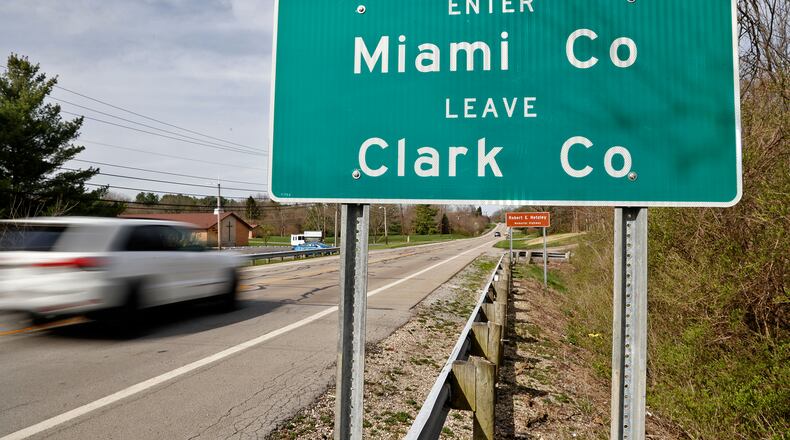According to the U.S. Census estimate for 2020 to 2022, Ohio’s population declined by 0.4%, the ninth-largest drop among the 50 states.
Clark County has shrunk every decade since at least 1990, according to Census data, falling from 147,000 residents to roughly 135,000 in that span of time.
Neighboring Champaign County grew from 1990-2010, then shrunk by 3.5% from 2010 to 2020. Miami County saw spurts of growth, increasing by 6.1% from 1990-2000, 3.7% from 2000-10, and 6.1% from 2010-20.
Part of Clark County’s strategic planning deals with stabilizing the population, then increasing it by 2025.
Work toward this goal includes developing and supporting housing in communities, implementing rural broadband, attracting retailers and entertainment experiences, and creating sewer and water improvements.
“The key to bringing more people to Clark County is more jobs and more housing,” said Mike Cooper, Clark County public information officer. “We’ve had several large employers … over the last 5 to 10 years, move to Clark County. And they play a key role in providing more jobs. If people want a great job and we can provide that for them, they’re more likely to move to Clark County.”
Companies like Topre America, Silfex and now Gabe’s continue to produce jobs in the area, Cooper said.
Greater Springfield Partnership President and CEO Mike McDorman said the partnership and its collaborators developed a strategy a decade ago to focus on jobs and job readiness. He said those efforts built an infrastructure to bring higher-paying jobs to the community.
“It takes a long time to get there… we’re there now, and the future looks very bright,” McDorman said. “We believe strongly that our population will begin to grow again. And grow to a point where it will help the community succeed.”
Several housing developments in progress in the county also aim to bring hundreds of housing units to the area over the next several years. McDorman said the city is still experiencing a housing shortage, but the city, county and other partners are working to fill the housing gap.
Clark County also has its own housing coalition to improve housing options, Cooper said.
Clark County development leaders are also boosting amenities that appeal to younger demographics and families, like retail options and entertainment outlets, McDorman said.
Ohio is projected to grow less than 1% over the next 30 years, according to Robert Graham, senior research scholar and associate director of the Scripps Gerontology Center at Miami University in Oxford.
Graham said some of the metro areas are seeing population increases because they tend to attract younger people, and job growth increases the likelihood of larger population.
The Columbus metro area is an example of this growth. According to population data, four of the five biggest increases are in the counties surrounding Columbus/Franklin County -- Union (6.54%), Delaware (5.69%), Pickaway (2.54%), Fairfield (2.50%).
Graham said factors in why the Columbus region is growing include The Ohio State University, which attracts a younger population, as well as major economic development wins such as the new Intel and Honda manufacturing facilities and the direct and indirect job creation that follows such large investments.
Graham said the state is also shifting older.
“By 2025, more than one in four Ohioans will be age 60 and older. It (the latest population estimate) really was not what we expected. We were projecting what the older population would be in 2020, but it missed the target and the reason was COVID-19,” he said.
While no one predicted COVID-19, the worldwide pandemic affected a disproportionate number of older people because of a higher death rate. Graham described the latest numbers as “a population blip.”
The outlier in the top five growing counties is Warren County, with 3.07% growth over the past two years. It’s proximity to Hamilton, Butler and Montgomery counties as well as the Cincinnati and Dayton metro areas, helps attracts new jobs and younger people.
Cuyahoga County, which includes the city of Cleveland, experienced a population decrease of 2.28%. Other counties experiencing big decreases are in south-central and southeastern Ohio that include Athens (-5.51%), Lawrence (-2.72%), Scioto (-2.46%), Vinton (-1.87%).
Alison Goebel, executive director of the Greater Ohio Policy Center, said the latest population estimate’s downward trend is about what was expected.
“It’s not new,” she said. “It’s been going on for the past 23 years. Central Ohio is blowing up with population with recent economic development wins, and the population trend is that people are moving to the Columbus region.”
Goebel said workforce will be key because many industries are diverse.
“A place with a 2% population loss won’t be put out of the running,” she said. “Ohio needs parallel policies to address fast-growth areas such as the Columbus region and to support ‘legacy communities’ who are not in growth mode. Ohio has a lot of assets depending on the needs of industry.”


